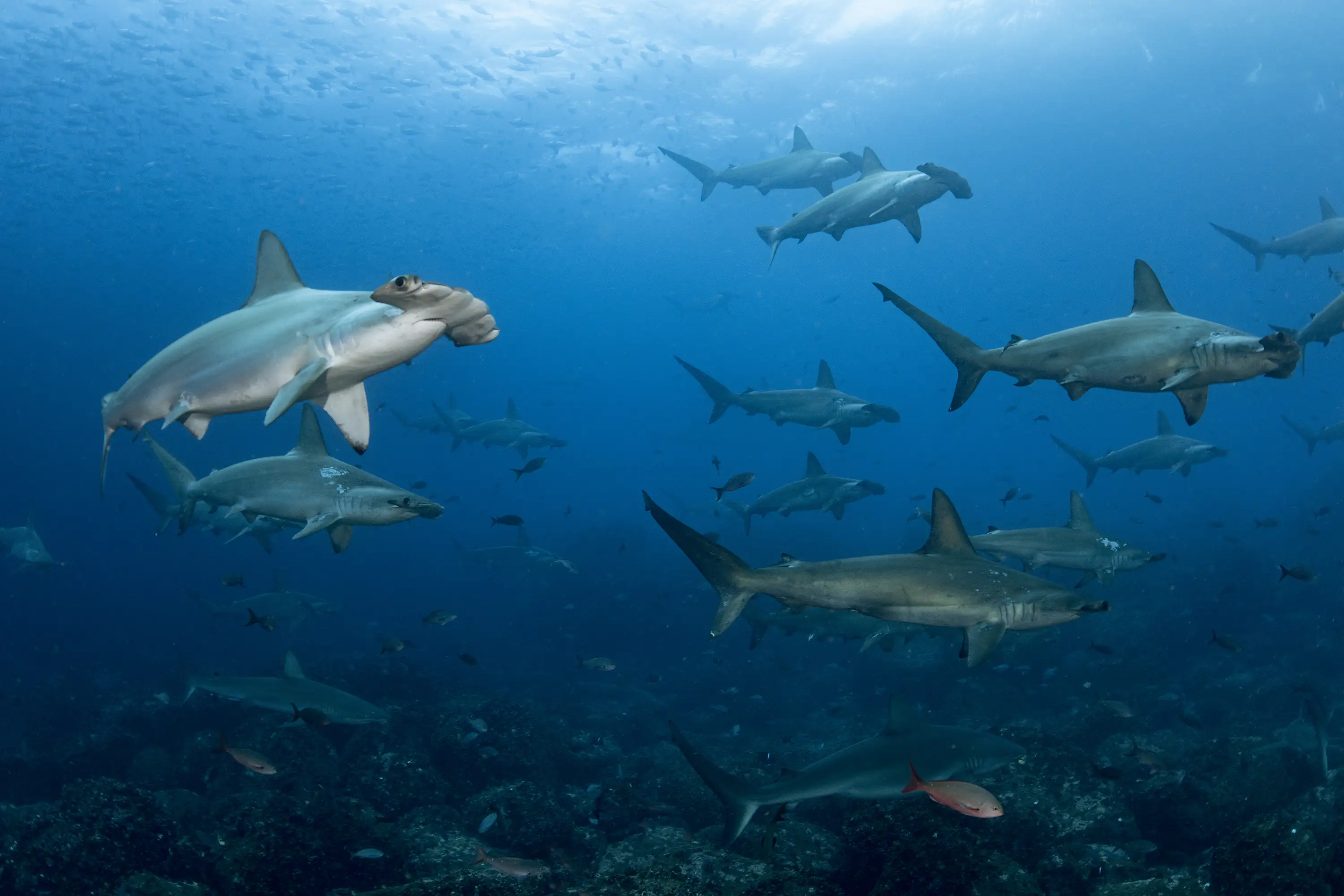
31. Scalloped Hammerhead Sharks
These creatures are almost ghosts. They are quite rare to see and so difficult to get close to that for many of us, getting a fantastic shot is a lifetime endeavor. There are very few places in the world that provide the opportunity to capture a nice image of scalloped hammerhead sharks. Getting the "shot" requires not only great photography skills, but also a lot of diving experience. Hammerheads love stronger current, limited visibility and darker light conditions. Since every single encounter with these shy animals tends to be unique, photographers don't get many opportunities to practice shooting under the same conditions, which means we have to be as prepared as possible for the encounter and make final adjustments to the actual conditions on the fly.
My tips to go around well:
- Stay calm and quiet: My initial recommendation reflects the importance of approaching our subject as closely as possible. Chasing these creatures makes absolutely no sense. We want to blend in with the underwater environment as best as possible, observe the scene and estimate where the right photo opportunity will arise in a moment. First, you want to understand shark behavior and movement paths so you can position yourself in the right spot. We want to separate ourselves slightly from the rest of the group far enough to be in the front line and have a bubble-free view. Calm down as much as possible to slow down breathing. When the encounter happens, hold your breath as long as you can and slowly blow the bubbles. Obviously, this technique interferes with the basic rules of diving, but the way you move and breathe has a major impact on shark behavior, and therefor directly determines success.
- Keep your rig prepared at all times! Focus on ambient light. Set your exposure values pointing the camera the direction you expect the sharks to show up. Shoot a probationary image and check the results. Adjust the settings if needed. Turn on your strobes. If you move to different spot or change the camera angle, repeat the procedure! Otherwise, you may not be able to react quickly when the hammerheads come out of nowhere and end up with incorrectly exposed images.
- Mind your approaching maneuver: When I spotted this shool of scalloped hammerheads in distance on early morning dive on Darwin, I hid behind a rock a nailed my exposure. I knew I would be shooting almost level in low situation, in decent visibility. I took a few quick breaths to raise my oxygen a bit and with finger on the shutter I started my approach. Long and slow fin strikes and the current brought me to the animals while I held my breath. I was able to shoot 7 images before the sound of exhaled bubbles scared them off.
- Equipment: In terms of choosing the right equipment for hammerheads, the best choice is a APC (crop sensor) DSLR combined with Tokina 10-17mm mostly set at 17mm. The problem is that hardly any APC sensor compares to a full frame sensor in terms handling high ISO. Therefor full frame DSLR or mirrorless camera combined with fish-eye lens (Sigma 15mm F/2.8, Sony 14mm FE) and a teleconverter (Kenko 1.4x) may be equally effective, producing sharp images with slightly narrower perspective. The rectilinear wide angle zoom lens is also an option, however I’m not a fan of the pincushion distortion in corners hence barely use it.
- Camera settings: Where the hammerheads are, in most cases there is not enough light available for a perfect exposure and so we need to accept certain compromise in image quality. Since we definitely don’t want to create blury underexposed images, we need to keep the shutter speed relatively fast (1/80 or higher, ideally above 1/125s). As for the F-stop, I would start as low as F4.5 on APC camera system and F5.6 on full frame. If the light conditions play along, the F7.1, F8 are optimal values to use. The ISO is the trade-off. Anything under ISO 800 keeps the noice invisible, ISO 800-1600 is acceptable, while everything above ISO 1600 comes at a cost in excessive noice, loss of colors and dynamic range. That said, the cost are acceptable at hi-end cameras. I regularly use ISO 3200 on my Nikon D850.
- Strobes power settings and positioning: It’s highly unlikely that our strobes will be firing within less than two meters of distance from sharks. Therefor we position our strobes far out (70-80cm from central paralax) and turn them slightly outwards. The more ambient light there is available and the better the visibility, the more power we can emit from our strobes. I would set my Subtronic Pro160s to 1/2 power and fire another probationary shot against an object within 2 meter distance and readjust power settings if needed.
Scalloped hammerhead sharks
Nikon D850
Seacam housing
Sigma 15mm FE F/2.8, Kenko 300 TC (1.4x)
2 x Subtronic Pro160s strobes @ 1/2 power
Camera settings: F/8, 1/100s, ISO 800
Location: Darwin Island, Galapagos, Ecuador
December 2020

